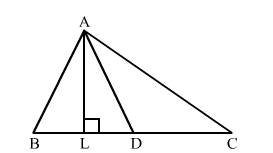
In △ABC, AD is a median and AL ⊥ BC.
Prove that
(i) $\mathrm{AC}^{2}=\mathrm{AD}^{2}+\mathrm{BC} \cdot \mathrm{DL}+\left(\frac{\mathrm{BC}}{2}\right)^{2}$
(ii) $\mathrm{AB}^{2}=\mathrm{AD}^{2}-\mathrm{BC} \cdot \mathrm{DL}+\left(\frac{\mathrm{BC}}{2}\right)^{2}$
(iii) $\mathrm{AB}^{2}+\mathrm{AC}^{2}=2 \mathrm{AD}^{2}-\frac{1}{4} \mathrm{BC}^{2}$
(a)
In right triangle ALD
Using Pythagoras theorem, we have
AL2 = AD2 − DL2 .....(1)
Again, In right triangle ACL
Using Pythagoras theorem, we have
$\mathrm{AC}^{2}=\mathrm{AL}^{2}+\mathrm{LC}^{2}$
$=\mathrm{AD}^{2}-\mathrm{DL}^{2}+(\mathrm{DL}+\mathrm{DC})^{2} \quad[\mathrm{Using}(1)]$
$=\mathrm{AD}^{2}-\mathrm{DL}^{2}+\left(\mathrm{DL}+\frac{\mathrm{BC}}{2}\right)^{2} \quad[\because \mathrm{AD}$ is a median $]$
$=\mathrm{AD}^{2}-\mathrm{DL}^{2}+\mathrm{DL}^{2}+\left(\frac{\mathrm{BC}}{2}\right)^{2}+\mathrm{BC} \cdot \mathrm{DL}$
$\therefore \mathrm{AC}^{2}=\mathrm{AD}^{2}+\mathrm{BC} \cdot \mathrm{DL}+\left(\frac{\mathrm{BC}}{2}\right)^{2} \quad \ldots(2)$
(b)
In right triangle ALD
Using Pythagoras theorem, we have
AL2 = AD2 − DL2 .....(3)
Again, In right triangle ABL
Using Pythagoras theorem, we have
$\mathrm{AB}^{2}=\mathrm{AL}^{2}+\mathrm{LB}^{2}$
$=\mathrm{AD}^{2}-\mathrm{DL}^{2}+\mathrm{LB}^{2} \quad[\mathrm{Using}(3)]$
$=\mathrm{AD}^{2}-\mathrm{DL}^{2}+(\mathrm{BD}-\mathrm{DL})^{2}$
$=\mathrm{AD}^{2}-\mathrm{DL}^{2}+\left(\frac{1}{2} \mathrm{BC}-\mathrm{DL}\right)^{2}$
$=\mathrm{AD}^{2}-\mathrm{DL}^{2}+\left(\frac{1}{2} \mathrm{BC}-\mathrm{DL}\right)^{2}$
$=\mathrm{AD}^{2}-\mathrm{DL}^{2}+\left(\frac{\mathrm{BC}}{2}\right)^{2}-\mathrm{BC} \cdot \mathrm{DL}+\mathrm{DL}^{2}$
$\therefore \mathrm{AB}^{2}=\mathrm{AD}^{2}-\mathrm{BC} \cdot \mathrm{DL}+\left(\frac{\mathrm{BC}}{2}\right)^{2} \quad \ldots(4)$
(c) Adding (2) and (4), we get
$\mathrm{AC}^{2}+\mathrm{AB}^{2}=\mathrm{AD}^{2}+\mathrm{BC} \cdot \mathrm{DL}+\left(\frac{\mathrm{BC}}{2}\right)^{2}+\mathrm{AD}^{2}-\mathrm{BC} \cdot \mathrm{DL}+\left(\frac{\mathrm{BC}}{2}\right)^{2}$
$=2 \mathrm{AD}^{2}+\frac{\mathrm{BC}^{2}}{4}+\frac{\mathrm{BC}^{2}}{4}$
$=2 \mathrm{AD}^{2}+\frac{1}{2} \mathrm{BC}^{2}$
Click here to get exam-ready with eSaral
For making your preparation journey smoother of JEE, NEET and Class 8 to 10, grab our app now.
